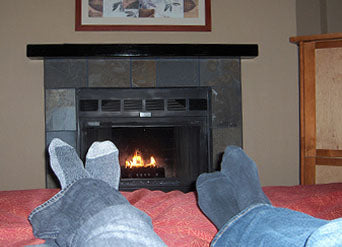How to Enjoy Soft, Warm and Pain-Free Feet This Winter
Posted by JB Smith, Co-Owner on

Winter is officially here! We’ve made it through New Year’s Eve, but how are our feet going to survive until spring? Unfortunately, for most us of, cold weather doesn’t call for hibernation, and this chilly season can do real damage to your feet, despite more layers of protection between your feet and the big bad world.
While we can avoid the pitfalls of summer shoes in the next few months, winter brings its own set of foot problems. We must remain on top of our foot health no matter what the weather. We’ve got some ideas on how to deal with winter feet.
Dry, Rough Skin
The moisture of certain winter weather, like snow and sleet, can’t hide the fact that, overall, winter air is dry. This, matched with warm and dry indoor heating can cause major dry skin on the heels of your feet. Dehydrated skin can lead to painful cracks that become difficult to heal. To avoid scaly skin, make moisturizer your friend. Even if you don’t normally use foot creams during the rest of the year, winter is the time to start.
Use a gentle exfoliating foot scrub and apply lotion to your feet after your shower or bath to lock in moisture and soften your skin. You can use a pumice stone every couple of days to rid your feet of flakiness, but beware: aggravating a deep existing crack will open your body to bacterial infections. So if you are already dealing with heel cracks, don’t pick. Instead, use a cream for intense dryness, avoid harsh soaps, wear materials that minimize friction and up your H20 intake. Drinking more water will lead to better-hydrated feet. See a doctor if your skin condition doesn’t improve.
Keeping your feet warm (see below) will also improve blood flow to the area; this increased circulation will help nourish skin cells, keeping your skin healthy and smooth.
Cold Feet
Do your feet turn into ice cubes once the temperatures drop? If you already suffer from poor circulation, you may start to believe your toes are actually twinkling – like icicles! As your body adjusts to the cold, it focuses more blood to your vital organs, leaving your extremities, like hands and feet, to suffer the consequences. If you’re outdoors for long periods of time in freezing weather, keep an eye out for white or yellow patches, numb skin and a tingling feeling as your toes get warm again. This is frostnip, which, for people with circulation problems, can quickly become the more serious frostbite.
Wet feet have extra trouble getting warm. Never walk in the snow in dress shoes. Keep an extra pair of moisture-wicking socks with you if you’re concerned you may find yourself in a snowy situation. The right footwear will have a water-resistant top layer to keep out cold, wet weather.
The winter is the best time to invest in a pair of thick comfortable socks and quality slippers. Sitting in your slippers by the fire - isn't it just perfect visual of pure relaxation? Just do so with caution: getting too close to the source of heat or using foot heaters and warm foot baths may cause burns and ultimately dehydrate your feet. Furthermore, because one of the symptoms of diabetes is a loss of feeling in the feet, diabetics should avoid such methods completely, as well as take extra caution with their foot health when outdoors in the cold.
Another way to warm up your feet: wear a hat! The body loses loads of heat through the head. Any such loss of body heat directly affects how cold your feet are; locking the heat in will maintain the proper blood flow to your extremities.
Ingrown Toenails
While it is very important to keep your feet in the proper winter footwear, one negative that might result from all of this coverage is ingrown toenails. With less freedom to move around, toes are squished together inside your boots and heavy socks. The skin around your toenails puts pressure on the nail; this can cause your nail to grow into the skin. Avoid this painful downfall of winter by cutting and filing your toenails straight across. Don’t play with potential ingrowns yourself, as this could lead to an even more painful infection. Your podiatrist can help you remove the ingrown toenail in a safe way to avoid any future issues. Also, select winter shoes with a roomy enough toe box to give your toes some personal space.
Slips & Falls
We know it is cold outside, but stop hurrying! Even if you’re in a rush, take smaller steps. Big fast steps make it harder to find your balance if you feel yourself on uneasy ground. Slippery surfaces call for slow movements. Also, pay attention to your path. Ice patches may be clear, but if you’re paying attention, you should be able to avoid ending up seated on top of it. Sidewalks may also crack due to relentless winter precipitation, so keeping your focus on the ground will help you make your way around broken and lifted surfaces.
A trip on the ice can easily become a trip to the doctor. Winter means icy sidewalks mean a full waiting room of patients for your local podiatrists. The right footwear is an important stop on the road to healthy and non-injured winter feet. Make sure your shoes have ankle support, a stable heel and outer soles with the traction necessary to go up against uneven surfaces. If you have shoes for certain special occasions that don’t provide these things, try an overshoe with a good grip. Well-fitting shoes will also minimize other foot health issues, which in itself will help keep you on your feet. Walking comfortably and without pain will let you walk normally and less at risk for slips.
